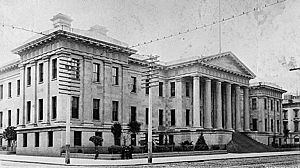Shilling (Australian) facts for kids
| Australia | |
| Value | Pre-decimal: 1⁄20 Australian pound Decimal: 0.10 Australian dollar |
|---|---|
| Mass | 5.65 g |
| Diameter | 23.5 mm (0.925 in) |
| Edge | Round (milled) |
| Composition | 92.5% silver, 7.5% copper (1910-1944). 50% silver, 40% copper, 5% zinc, 5% nickel (1946-1963) |
| Circulation | 1910-1963 |
| Obverse | |
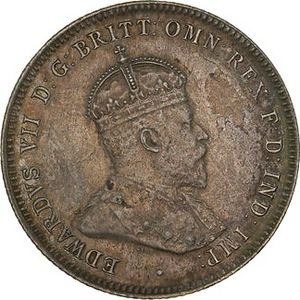 |
|
| Design | Visage of King Edward VII |
| Designer | George W. De Saules |
| Design discontinued | 1911 |
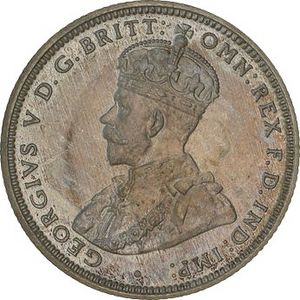 |
|
| Design | Visage of King George V |
| Designer | Sir Edgar B Mackennal |
| Design discontinued | 1936 |
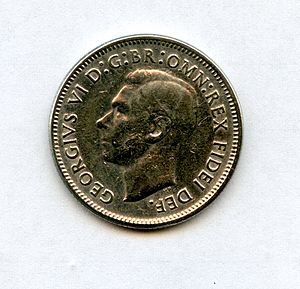 |
|
| Design | Visage of King George VI |
| Designer | Thomas H. Paget |
| Design discontinued | 1952 |
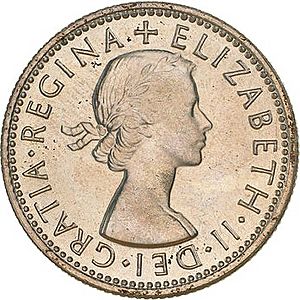 |
|
| Design | Visage of Queen Elizabeth II |
| Designer | Mary Gillick |
| Design discontinued | 1963 |
| Reverse | |
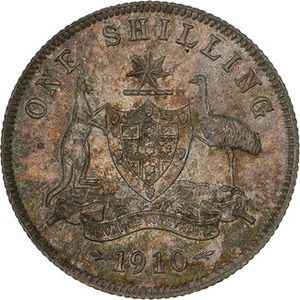 |
|
| Design | Australian Coat of Arms (1908) |
| Designer | William Henry James Blakemore |
| Design discontinued | 1936 |
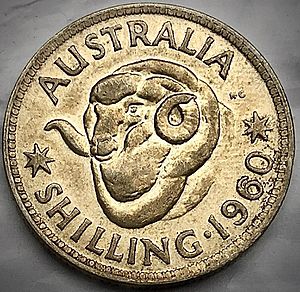 |
|
| Design | Merino Ram's head |
| Designer | George Kruger Gray |
| Design discontinued | 1963 |
The shilling, sometimes called a "bob", was a silver coin used in Australia. It was part of Australia's money system before it switched to dollars and cents. The Australian shilling was based on the British shilling.
Australia started making its own shillings in 1910. This happened after the Coinage Act 1909 was passed. The shilling was one of several silver coins, which also included the florin (two shillings), the sixpence, and the threepence. Shillings were made from 1910 until 1963.
One big change to the shilling's look happened in 1938. The back of the coin changed from showing the Australian Coat of Arms to a Merino ram's head.
Contents
History of the Australian Shilling
The Australian shilling first appeared in 1910. It was part of a new set of Australian coins. These coins included the florin, sixpence, and threepence. All these early coins had the head of King Edward VII on them.
Before Decimal Money
Before Australia became a country in 1901, British shillings were used. The British Empire sent these coins around the world. This made them a common currency.
After Australia became a federation, it decided to create its own money. The first Australian shillings were made in England. They were made at the Heaton Mint in Birmingham and the Royal Mint in London. In 1916, Australia started making its own silver coins. This happened at the Melbourne Mint.
Over the next 50 years, the Australian shilling changed very little. However, its design did change when new kings and queens came to the throne. Also, there were some years when no shillings were made. These years included 1923, 1929, 1930, 1932, 1937, 1947, 1949, and 1951.
Switching to Dollars and Cents
In the late 1950s and early 1960s, Australia got ready to change its money system. This big change was called "C-Day" and happened on Monday, February 14, 1966. To get ready, the Australian government stopped making shillings after 1963.
After "C-Day", all old Australian coins were slowly taken out of use. The shilling became worth 10 cents in the new Australian dollar system.
The government also ran a big advertising campaign. They used TV and radio ads to teach people about the new money. A cartoon character named 'Dollar Bill' helped explain the changes. This helped Australians understand the new system.
Different Types of Shillings
There were several types of Australian shillings. This was because the designs on the front and back changed over time. Also, the metals used to make the coin changed in 1946.
Mint Marks on Shillings
Coins sometimes have small letters called "mintmarks." These letters show where the coin was made. From 1910 to 1915, shillings had "H" or "L" mintmarks. "H" meant it was made at the Ralph Heaton Mint in Birmingham. "L" meant it was made at the Royal Mint in London.
Later, Australian mints also made shillings. The Melbourne Mint sometimes put an "M" under the date. Shillings were also made at the Sydney Mint ("S"), the San Francisco Mint ("USAS"), and the Perth Mint ("P").
Shilling Designs
The Australian shilling had two main designs. One was on the back (reverse) and one was on the front (obverse).
Back (Reverse) Designs
The first design on the back of the shilling was the 1908 Australian Coat of Arms. This design was used from 1910 to 1936. It was created by William Henry James Blakemore. This was Australia's first official Coat of Arms. It showed a shield with a cross and stars. Around the shield were six smaller shields. Above it was a seven-pointed star, which stands for the Federation of Australia.
The second design on the back was a Merino ram's head. This design was used from 1938 to 1963. It was created by George Kruger Gray. His initials, "KG," were on the coin. This ram design was based on a real champion ram from a sheep show in 1932. The ram's head was so well-designed that it was chosen for the coin. This same ram was also shown on the 50-cent coin in 1991.
Front (Obverse) Designs
The front of the shilling always showed the head of the ruling British monarch.
- The first shillings in 1910 had King Edward VII.
- From 1911 to 1936, the coins showed King George V.
- After King George V, Edward VIII was king for a short time. No Australian coins with his portrait were officially released.
- When George VI became king, his portrait was on the coins from 1938 to 1952.
- After Queen Elizabeth II became queen, her portrait appeared on shillings from 1953 to 1963.
By tradition, each new monarch on coins faced the opposite direction from the one before them.
What Metals Were Used?
The Coinage Act 1909 said that silver coins, like shillings, should be made of "standard" silver. This meant a mix of 92.5% silver and 7.5% copper. This mix was used from 1910 to 1938.
After World War II, the price of silver went up a lot. The silver in the coins was almost worth more than the coin itself! So, Australia changed the metal mix. From 1946 to 1963, shillings were made of 50% silver, 40% copper, 5% zinc, and 5% nickel. Today, Australia's "silver" coins do not contain any real silver.
How Australian Shillings Were Made
Before Australia made its own shillings, its money was made by branches of the British Royal Mint. These were in Sydney (opened 1855), Melbourne (opened 1872), and Perth (opened 1899).
The Royal Australian Mint did not make any shillings. It started making coins two years after shilling production stopped. It only made coins for the new decimal currency.
Australian shillings were made both in Australia and overseas. From 1910 to 1915, they were made in Birmingham and London. In 1916, Melbourne started making them. Between 1916 and 1936, the Sydney and Melbourne Mints made most of Australia's shillings.
During World War II, these Australian mints had trouble making enough coins. So, Australia allowed some coins to be made in the United States. Shillings were made at the San Francisco Mint. These coins have "S" mintmarks.
Mintages
This table shows how many Australian shillings were made each year. The numbers are in thousands. For example, 2,536 means 2,536,000 shillings were made.
| Edward VII | George V | George VI | Elizabeth II |
|---|---|---|---|
| 1910 - 2,536 | 1911 - 1,000 | 1938 - 1,484 | 1953 - 12,204 |
| 1912 - 1,000 | 1939 - 1,520 | 1954 - 16,188 | |
| 1913 - 1,200 | 1940 - 760 | 1955 - 7,492 | |
| 1914 - 3,300 | 1941 - 2,500 | 1956 - 6,064 | |
| 1915 - 800 (+500) | 1942 - 2,920 (+4000) | 1957 - 12,668 | |
| 1916 - 5,141 | 1943 - 1,580 | 1958 - 8,132 | |
| 1917 - 5,274 | 1944 - 14,576 (+8,000) | 1959 - 10,156 | |
| 1918 - 3,761 | 1946 - 10,072 (+1,316) | 1960 - 16,408 | |
| 1920 - 1,642 | 1948 - 4,132 | 1961 - 30,100 | |
| 1921 - 522 | 1950 - 7,188 | 1962 - 6,592 | |
| 1922 - 2,039 | 1952 - 19,644 | 1963 - 10,072 | |
| 1924 - 673 | |||
| 1925 - 1,449 | |||
| 1926 - 2,352 | |||
| 1927 - 1,416 | |||
| 1928 - 664 | |||
| 1931 - 1,000 | |||
| 1933 - 220 | |||
| 1934 - 480 | |||
| 1935 - 500 | |||
| 1936 - 1,424 |


